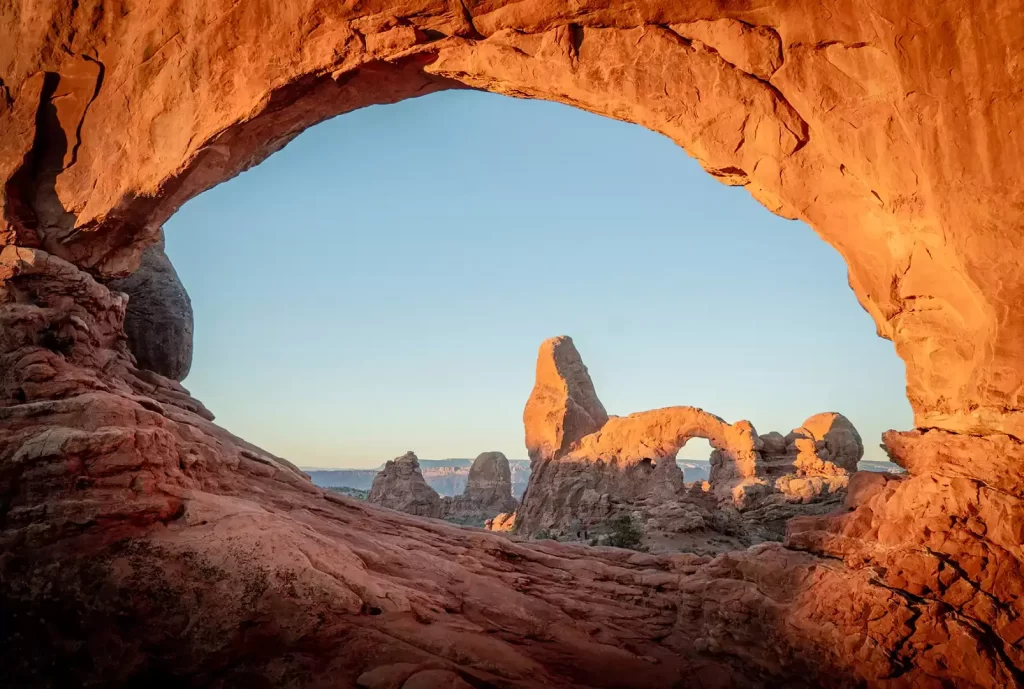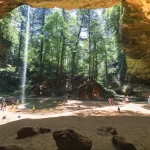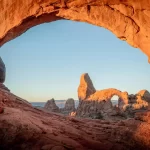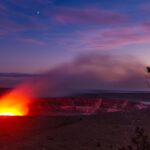Tucked away in the high desert of eastern Utah lies one of the most awe-inspiring landscapes in the American Southwest – Arches National Park. This iconic park is home to over 2,000 natural sandstone arches, soaring pinnacles, massive balanced rocks, and intricate patterns etched into crimson colored cliff walls. From Delicate Arch to Landscape Arch and beyond, Arches serves up one jaw-dropping scene after another. In this article we talk about Arches National Park, Utah- Guide for camping.
And one of the best ways to experience this natural wonderland is by camping right within the park itself. Pitch your tent or park your RV beneath the Milky Way with the fiery glow of Turret Arch lighting up the night sky. Wake up to catch the first rays of dawn spreading across the Windows Section. Spend your days hiking to iconic landmarks and your nights gathered around the campfire telling stories under a canopy of stars.
If this sounds like your kind of camping adventure, read on for everything you need to know to plan an unforgettable Arches camping trip!
Choosing a Campground in Arches National Park
Arches National Park offers two developed campgrounds for overnight visitors. The Devils Garden Campground is located 18 miles from the park entrance at the end of the main park road, while the Squaw Flat Campground sits near the entrance just 5 miles from the visitor center.
Devils Garden Campground
The Devils Garden Campground is the more popular and convenient basecamp for exploring Arches National Park. Situated right alongside the Devils Garden Trailhead, campers have direct access to viewpoints for Landscape Arch, Partition Arch, Private Arch, and more. The campground features 50 individual sites available on a first-come, first-served basis year-round.
In the height of summer, sites often fill by mid-morning so early arrival is key. Each campsite includes a picnic table, fire ring with grill, and upright bear-proof food storage locker. Drinking water and flush toilets are available seasonally. There are no RV hookups, though sites can accommodate both tents and RVs up to 30 feet in length. Generators are prohibited.
Squaw Flat Campground
For a more primitive and peaceful experience, consider camping at the modest Squaw Flat Campground near the park entrance. This campground offers 26 non-electric sites on a first-come, first-served basis.
While spartan in amenities with just vault toilets and no running water, it does allow campfires and is open to both tents and RVs. The downside is the location 5 miles from the visitor center and over 20 miles from iconic landmarks like Delicate Arch. But with fewer crowds, unobstructed views of the La Sal Mountains, and even the occasional moose wandering through, it makes a nice alternative for a serene camping getaway.
Backcountry Camping in Arches
Venture beyond the boundaries of the developed campgrounds and you’ll discover boundless backcountry camping opportunities. From remote desert washes to ridges with limitless views, Arches serves up endless potential sites to pitch your tent under the stars.
Permits are required for all backcountry camping, with a limit of 10 permits issued per day. Sites are assigned at the time of permit issuance on a first-come, first-served basis. Backcountry camping is limited to certain zones and subject to a variety of common-sense regulations to preserve the fragile desert ecosystem.
When choosing a backcountry site, stay aware of potential flood zones in drainages and washes. Also avoid camping at the bases of arches or walls where danger from falling rocks exists. Leave No Trace principles are essential to protect the landscape and ensure future visitor enjoyment.
Plan Your Visit: Camping Reservations and Permits
With Arches popularity continuing to skyrocket, planning your visit in advance is highly recommended to secure a campsite and required permits. Here are some key things you’ll need to know:
Campground Reservations
Neither of Arches campgrounds accept reservations, operating solely on a first-come, first-served basis instead. Your best bet is to arrive early in the day to claim a site, especially during peak visitation months. Monitoring campground occupancy online can also help gauge availability to time your arrival.
Backcountry Permits
Permits are required for all backcountry camping within Arches National Park, with a maximum of 10 permits issued per day. The cost is $5 per permit plus $20 per group per night. Permits must be obtained in person no more than 48 hours in advance at the Backcountry Desk at the Visitor Center. Only three nights of backcountry camping are allowed per seven day period.
Entrance Passes
All private vehicles entering Arches National Park require a park entrance pass. Options include Arches specific annual passes or broader America the Beautiful annual passes allowing access to all National Parks and Federal Recreational Lands. You can also pay a per vehicle seven day pass just to visit Arches.
Best Time to Visit Arches for Camping
With over 1.5 million visitors every year, Arches National Park sees crowds at all times. But weather patterns do impact campground availability and comfort. Here’s an overview of the pros and cons of visiting during different seasons:
Summer
July and August are the most popular months, bringing very hot weather and bigger crowds. Campsites fill fastest and you’ll encounter more people on the trails. But long hours of daylight and warm nights make for pleasant camping. Just prepare for intense sun and occasional thunderstorms.
Fall
September and October offer ideal weather with cooler temps and smaller crowds. Most facilities are still open and you’ll enjoy amazing photography conditions at sunrise/sunset. Beware fall can also deliver sudden winter snow squalls.
Winter
Frigid nights and snowy conditions limit winter camping. But you’ll discover beautiful desert scenery dusted in white with rare solitude on the trails. Winter weather is highly variable – come prepared for anything from dry and sunny to whiteout blizzard conditions.
Spring
April through May offer moderate weather and smaller crowds before summer visitation spikes. But some park facilities may still be closed early season. Flash flooding can be an issue so avoid camping in washes and drainages.
Packing List for Camping in Arches National Park
The desert environment of Arches National Park demands careful preparation with extremes in both hot and cold conditions. Use this packing checklist to be ready for anything:
Camping Gear
– Tent/RV in good condition
– Sleeping bags rated for cold weather
– Sleeping pads for insulation
– Camp chairs, camp table
– Headlamps with spare batteries
– Lanterns (no open flames or candles allowed)
– Cooking stove and fuel (campfires only allowed in grills)
– Firewood (gathering wood prohibited)
– Cooler with ice
– Reusable water bottles, jugs
– Food storage containers
– Bear canister (required for backcountry)
– Garbage bags
Clothing/Footwear
– Lightweight, breathable layers
– Fleece or down jackets for cold
– Rain poncho or rain jacket
– Warm gloves and hat
– Hiking pants and shorts
– Hiking shoes – broken in!
– Sandals/camp shoes
– Socks – wool for hiking
Outdoor Gear
– Daypack for hikes
– Hiking poles
– Insect repellent
– Sunscreen/lip balm
– Sunglasses
– Brimmed hat
– Bandanas/buff
– Headlamp/flashlight
– Compass/maps, GPS
– Camp towel, toiletries
– First aid kit
– Duct tape
Where to Camp in Arches National Park
With endless natural beauty spanning 76,679 acres, choosing where to pitch your tent in Arches can be overwhelming. Consider these areas to maximize your experience:
Devils Garden
Direct access to one of the most popular hiking trails makes the Devils Garden Campground the ideal basecamp for exploring. Rise early to beat crowds on the Devils Garden Loop Trail to icons like Landscape Arch, Partition Arch, Tunnel Arch, Pine Tree Arch, and the unforgettable Delicate Arch.
Balanced Rock
The Windows Section near Balanced Rock delivers the highest concentration of named arches visible from one area. From your campsite, enjoy sunrises at the Cove of Caves and hike to attractions like Turret Arch, North Window Arch, South Window Arch and the parade of arches along the Windows Primitive Loop.
Fiery Furnace
Explore the maze of narrow sandstone canyons and giant fins known as the Fiery Furnace. Obtain permits for the ranger-guided hikes or apply for more exclusive permits to lead your own small group through this unique landscape. Access the Fiery Furnace from campsites at the Devils Garden area.
Delicate Arch Viewpoint
While not technically located inside Arches, the viewpoint for Delicate Arch within neighboring Canyonlands National Park provides a breathtaking vantage for sunset and sunrise on this iconic landmark. I sincerely hope you find this “Arches National Park, Utah- Guide for camping” article helpful.






